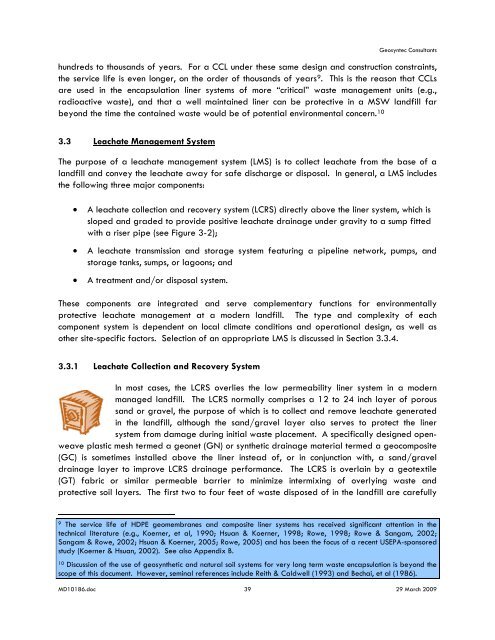AREA A/B ENGINEERING REPORT - Waste Management
AREA A/B ENGINEERING REPORT - Waste Management
AREA A/B ENGINEERING REPORT - Waste Management
You also want an ePaper? Increase the reach of your titles
YUMPU automatically turns print PDFs into web optimized ePapers that Google loves.
Geosyntec Consultants<br />
hundreds to thousands of years. For a CCL under these same design and construction constraints,<br />
the service life is even longer, on the order of thousands of years 9 . This is the reason that CCLs<br />
are used in the encapsulation liner systems of more “critical” waste management units (e.g.,<br />
radioactive waste), and that a well maintained liner can be protective in a MSW landfill far<br />
beyond the time the contained waste would be of potential environmental concern. 10<br />
3.3 Leachate <strong>Management</strong> System<br />
The purpose of a leachate management system (LMS) is to collect leachate from the base of a<br />
landfill and convey the leachate away for safe discharge or disposal. In general, a LMS includes<br />
the following three major components:<br />
• A leachate collection and recovery system (LCRS) directly above the liner system, which is<br />
sloped and graded to provide positive leachate drainage under gravity to a sump fitted<br />
with a riser pipe (see Figure 3-2);<br />
• A leachate transmission and storage system featuring a pipeline network, pumps, and<br />
storage tanks, sumps, or lagoons; and<br />
• A treatment and/or disposal system.<br />
These components are integrated and serve complementary functions for environmentally<br />
protective leachate management at a modern landfill. The type and complexity of each<br />
component system is dependent on local climate conditions and operational design, as well as<br />
other site-specific factors. Selection of an appropriate LMS is discussed in Section 3.3.4.<br />
3.3.1 Leachate Collection and Recovery System<br />
In most cases, the LCRS overlies the low permeability liner system in a modern<br />
managed landfill. The LCRS normally comprises a 12 to 24 inch layer of porous<br />
sand or gravel, the purpose of which is to collect and remove leachate generated<br />
in the landfill, although the sand/gravel layer also serves to protect the liner<br />
system from damage during initial waste placement. A specifically designed openweave<br />
plastic mesh termed a geonet (GN) or synthetic drainage material termed a geocomposite<br />
(GC) is sometimes installed above the liner instead of, or in conjunction with, a sand/gravel<br />
drainage layer to improve LCRS drainage performance. The LCRS is overlain by a geotextile<br />
(GT) fabric or similar permeable barrier to minimize intermixing of overlying waste and<br />
protective soil layers. The first two to four feet of waste disposed of in the landfill are carefully<br />
9 The service life of HDPE geomembranes and composite liner systems has received significant attention in the<br />
technical literature (e.g., Koerner, et al, 1990; Hsuan & Koerner, 1998; Rowe, 1998; Rowe & Sangam, 2002;<br />
Sangam & Rowe, 2002; Hsuan & Koerner, 2005; Rowe, 2005) and has been the focus of a recent USEPA-sponsored<br />
study (Koerner & Hsuan, 2002). See also Appendix B.<br />
10 Discussion of the use of geosynthetic and natural soil systems for very long term waste encapsulation is beyond the<br />
scope of this document. However, seminal references include Reith & Caldwell (1993) and Bechai, et al (1986).<br />
MD10186.doc 39 29 March 2009

















